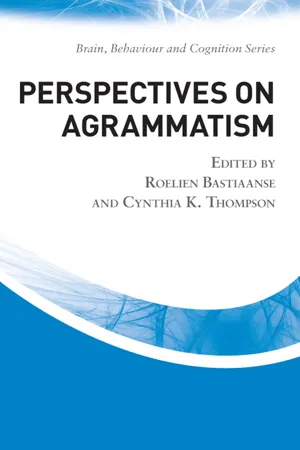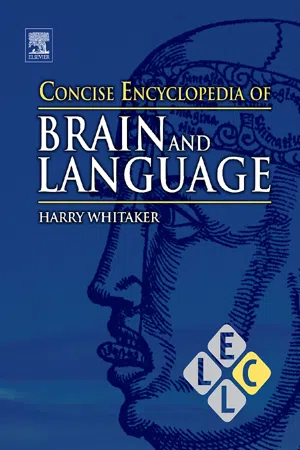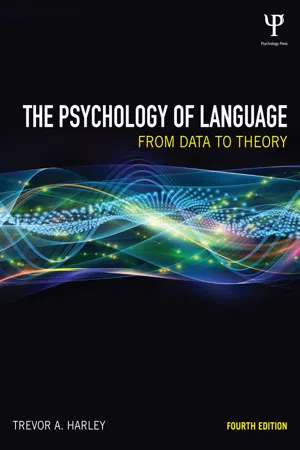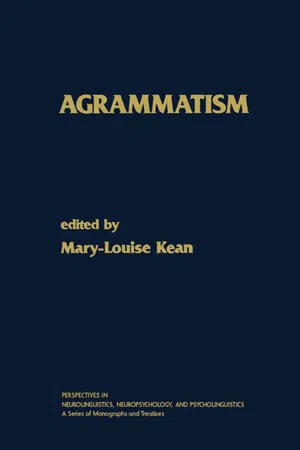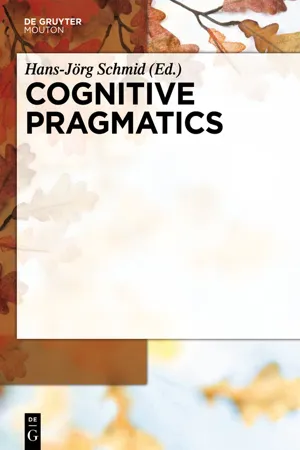Languages & Linguistics
Agrammatism
Agrammatism is a language disorder characterized by difficulty in producing and understanding grammatically correct sentences. It is often associated with damage to the brain's language centers, such as Broca's area. People with agrammatism may have trouble with verb tenses, word order, and other grammatical aspects of language.
Written by Perlego with AI-assistance
9 Key excerpts on "Agrammatism"
- eBook - ePub
- Roelien Bastiaanse, Cynthia K. Thompson, Roelien Bastiaanse, Cynthia K. Thompson(Authors)
- 2012(Publication Date)
- Psychology Press(Publisher)
1 Introduction to Agrammatism
Cynthia K. Thompson and Roelien BastiaanseThe study of Agrammatism has undergone a considerable transformation in the last two decades. We, therefore, offer Perspectives on Agrammatism , which consists of chapters reviewing contemporary issues, theories, and research on this intriguing disorder. The chapters are written from different perspectives by experts in the field, representing several disciplines within neurolinguistics and aphasiology, including communication sciences and disorders, linguistics, neurology, and psychology.Definition of Agrammatism
Agrammatism was initially characterized as affecting the linguistic structure of sentence production. For example, an aphasic person described by Deleuze in 1898 used only the infinitive form of verbs and no pronouns (cited in Pitres 1898). This idea prevailed in reports of Agrammatism published up to the 1960s and early 1970s. Alajouanine (1968) suggested the following constellation of deficits: “reduction of the sentence to its skeleton, relative abundance of substantives, almost invariable use of verbs in the infinitive, with suppression of the small words (the function words of language) and loss of grammatical differentiation of tense, gender, number, as well as of subordination” (p. 84). In 1973 Tissot, Mouonin and Lhermitte described Agrammatism as including the following:(a) deletion of function words; (b) production of a predominance of nouns, at the expense of verbs; (c) loss of verb inflection, with substitution of the infinitive for finite verb forms; (d) loss of agreement of person, number, and gender.Salomon (1914) and other contemporaries, including Arnold Pick (1851–1924), favored the idea that these production patterns resulted from the effort required to produce speech, suggesting that deletion of semantically uninformative morphemes is an adaptation made for the sake of economy of effort. Pick (1913) suggested that the impoverished grammar of aphasic speakers was a regression from “conventional syntax” to the “syntax of thoughts” and the typical telegraphic speech was the consequence of an economy principle of the damaged cerebral organ, resulting in omission of redundant elements (i.e. free-standing and bound grammatical morphemes). Agrammatism, in Pick’s words, could be considered “Notsprache” (“emergency speech”), reflecting adaptation to the deficit. Pick’s ideas can be seen as the predecessor of the adaptation theory as formulated by Kolk (Kolk & Heeschen 1990; see later). - eBook - PDF
- Harry A. Whitaker(Author)
- 2010(Publication Date)
- Elsevier(Publisher)
Stromswold, K, Caplan, D, Alpert, N, et al. (1996). ‘Localization of syntactic comprehension by positron emission tomography.’ Brain and Language 52: 452–473. Agrammatism G. Miceli ã 2003 Elsevier Science (USA). All rights reserved. Agrammatism is an aphasic disorder characterized by violations of grammatical rules in the subject’s speech. Its most prominent feature is the difficulty using ‘‘func-tion’’ words (freestanding grammatical morphemes, such as articles, prepositions, auxiliary verbs, and clitic pro-nouns; bound grammatical morphemes, such as verb and noun inflections, etc.), in the presence of relative sparing of ‘‘content’’ words (nouns, adjectives, and verbs). It fre-quently appears in the context of the nonfluent, dysarthric, and dysprosodic speech characteristic of Broca’s aphasia. In its mildest form, it is characterized by fairly complex sentences with occasional omissions of function words (e.g., ‘‘Then admitted again . . . because pain always feel. Take pills but no sleep . . . . Then neurologist give sleeping pill, but I not sleep’’). In more severe cases, speech consists of simple sentences lacking function words (e.g., ‘‘In the morning wear skirt . . . then bath . . . then wash . . . then exercise . . . always; then my daughter . . . go work). In the most severe cases, it is reduced to one-word utterances, often without recoverable grammatical structure (e.g., ‘‘Me . . . home . . . headache . . . dead!’’). The features of agrammatic speech were first studied in German-speaking subjects in the early 1900s. However, the characterization of the disorder was critically influ-enced by later analyses conducted on English-speaking aphasics. Thus, for a long time the hallmark of agramma-tism was deemed to be the omission of function words, both freestanding and bound to word roots. Studies con-ducted in the early 1980s on languages other than English (e.g., Italian, Hebrew, and German) forced the reconsider-ation of this view. - eBook - ePub
The Psychology of Language
From Data to Theory
- Trevor A. Harley(Author)
- 2013(Publication Date)
- Psychology Press(Publisher)
Figure 13.14 ). This categorization relates more to the links between the characteristics of the impaired speech and anatomical regions of the brain, while currently the emphasis is on developing more functional descriptions relating to psycholinguistic models of the impairments. It is now considered more useful to distinguish between fluent aphasia, which is characterized by fluent (though sometimes meaningless) speech, and non-fluent aphasia. At the same time we can also distinguish between those patients who can comprehend language and those who have a comprehension deficit. Traditional Broca’s-type aphasics are non-fluent with no obvious comprehension deficit, whereas traditional Wernicke’s-type aphasics are fluent with an obvious comprehension deficit. Bear in mind that no classification scheme for neuropsychological disorders of language is perfect: there are always exceptions and patients who appear to cut across categories (see Schwartz, 1984). Furthermore, all patients have some degree of anomia (word-finding difficulties, discussed in more detail below)—even agrammatic Broca’s aphasics (Dick et al., 2001).AgrammatismFigure 13.14Comparison between Broca’s and Wernicke’s aphasias.The syntactic disorder of non-fluent patients tells us a great deal about the processes involved in speech production. In traditional neuropsychology terms, such patients suffer from what has been labeled Agrammatism.Agrammatism has three components. First, there is a sentence construction deficit, such that patients have an impaired ability to output correctly ordered words. The words do not always form sentences, but look as though they are being output one at a time. In some cases, simple sentences can be generated (e.g., a patient might repeat “the old man is washing the window” as “the man is washing window. The man is old”; Ostrin & Schwartz, 1986). The disorder extends to sentence repetition, where complex phrases are simplified. Second, some parts of speech are better preserved than others. In particular, there is a selective impairment of grammatical elements, such that content words are best preserved, and function words and word endings (bound inflectional morphemes) are least well preserved. Third, although for some time it was thought that their comprehension was spared, some people with Agrammatism also have difficulty in understanding syntactically complex sentences (see Chapter 10 ). It is also possible that certain differences between agrammatic speakers reflect different adaptations to the deficit. For example, some people show better retention of bound morphemes, and others of free grammatical morphemes.Whether or not these components are dissociable is an important question. There has been considerable debate as to whether terms such as Broca’s aphasia and Agrammatism have any place in modern neuropsychology. The debate centers on whether Agrammatism is a coherent deficit: Do people with Agrammatism show symptoms that consistently cluster together, and hence, is there a single underlying deficit that can account for them? If it is a meaningful syndrome, we should find that the sentence construction deficit, grammatical element loss, and a syntactic comprehension deficit should always co-occur. A number of single-case studies have found dissociations between these impairments (Caplan et al., 1985; Goodglass & Menn, 1985; Miceli, Mazzucci, Menn, & Goodglass, 1983; Nespoulous et al., 1988; Saffran et al., 1980; Schwartz et al., 1987). - eBook - PDF
Linguistic Disorders and Pathologies
An International Handbook
- Gerhard Blanken, Jürgen Dittmann, Hannelore Grimm, John C. Marshall, Claus-W. Wallesch, Gerhard Blanken, Jürgen Dittmann, Hannelore Grimm, John C. Marshall, Claus-W. Wallesch(Authors)
- 2008(Publication Date)
- De Gruyter Mouton(Publisher)
(1979). Agrammatism: A phonological deficit? Cognition, 7, 69—83. Kolk, H. & Blomert, L. (1985). On the Bradley hypothesis concerning Agrammatism: The non-word-interference effect. Brain and Language, 26, 94—105. Levelt, W. J. M. (1989). Speaking: From Intention to Articulation. Cambridge, MA: MIT Press. Linebarger, M. C., Schwartz, M. F., & Saffran, E. M. (1983). Sensitivity to grammatical structure in so-called agrammatic aphasics. Cognition, 13, 361—392. Lukatela, K., Crain, S., & Shankweiler, D. (1988). Sensitivity to inflectional morphology in agram-matism: Investigation of a highly inflected lan-guage. Brain and Language, 33, 1—15. Matthei, E. H. & Kean, M.-L. (1989). Postaccess Processes in the Open vs. Closed Class Distinction. Brain and Language, 36, 163—180. McCarthy, R. & Warrington, E. K. (1985). Cate-gory-specificity in an agrammatic patient: The rel-ative impairment of verb retrieval and comprehen-sion. Neuropsychologia, 23, 709—727. Miceli, G., Silveri, M. C., Villa, G., & Caramazza, A. (1984). On the basis for the agrammatics’ dif-ficulty in producing main verbs. Cortex, 20, 207—220. O’Grady, W., Dobrovolsky, M., & Aronoff, M. (1989). Contemporary Linguistics. An Introduction. New York: St. Martins’s Press. Rosenthal, V. & Goldblum, M.-C. (1989). On cer-tain grammatical prerequisites for agrammatic be-haviour in comprehension. Journal of Neurolin-guistics, 4, 179—211. Saddy, J. D. (1990). Investigations into Grammat-15. Disorders of Lexical Morphology in Aphasia served feature of language impairment. - eBook - PDF
- Michael Arbib(Author)
- 2012(Publication Date)
- Academic Press(Publisher)
This is yet another instance of the confusion of terminological differences with empirical differences (Garrett and Kean, 1980). CONCLUSION Looking at Agrammatism from the perspectives of grammar, production, and comprehension where the models of the conceptualizations of language are mutually consistent, we begin, I think, to have a framework for the close scrutiny of functional deficits. Without such models, analysis of deficits will remain capricious; an anarchic approach to functional characterization has had no theoretical utility. Although this work is still in its early infancy, it does allow for the liberation of research from pretheoretic conceptions of the structure of lan-guage and human linguistic capacity. Agrammatism and at least some of its concomitants are no longer a random collection of symptoms; one begins to see some functional coherence to the symptom-complex. Experimental studies have enriched our conception of Agrammatism; no longer can one think of the agram-matic Broca's aphasie as a person with just a production deficit. The systema-tic analyses of Agrammatism which are beginning to emerge direct our attention to new avenues of inquiry where we can, I think quite safely, anticipate experi-mental research that will enrich our appreciation of the scope of the agrammatic deficit. And it is also quite clear that as such research proceeds our understanding of the structure of normal function will in turn be enhanced. REFERENCES Blumstein, S. (1973). A phonological investigation of aphasie speech. The Hague: Mouton. Bradley, D. C. (1978). Computational distinctions of vocabulary type. Unpublished Ph.D. disserta-tion, MIT. Bradley, D. C , and Garrett, M. F. (In preparation). Computational distinctions of vocabulary type. Bradley, D. C , Garrett, M. F., Kean, M.-L., Kolk, H., and Zurif, E. B. (In preparation). Distin-guishing vocabulary type: Normal versus agrammatic speakers. Bradley, D. C., Garrett, M. F., and Zurif, E. B. (1980). - eBook - ePub
- Mary-Louise Kean(Author)
- 2013(Publication Date)
- Academic Press(Publisher)
approached in terms of our currently best accounts of language structure and processing. In what follows we consider several such approaches.As mentioned at the start of this chapter, we examine first the notion that Agrammatism represents an overarching failure in the ability to specify fully syntactic features in language—that it is a failure that can be reconstructed in terms of the syntactic level of an adequate grammar. It will become apparent that, in carrying out this reconstruction, we are not seeking to explain Agrammatism as a “failure of competence.” Rather, our intention here is only to provide some details about the structural properties of Agrammatism; in effect, about what constitutes permissible syntactic forms for the agrammatic patient.We then shift our perspective to examine differences in the real-time processing characteristics underlying the use of lexical information by agrammatic aphasic patients and by patients with no evidence of brain damage. Here we seek the antecedents for the agrammatic patients’ inability to recover structural descriptions for sentences. Specifically, although the effects of focal left-sided damage may be accounted for in syntactic terms, we entertain the notion that these effects are, at least partially, the result of disruption to functional systems that are recruited by the linguistic system but which are themselves neither specific to any particular domain (such as that responsible for linguistic performance), nor to any particular input or output channel. - eBook - PDF
- Hans-Jörg Schmid(Author)
- 2012(Publication Date)
- De Gruyter Mouton(Publisher)
Agrammatism, automatic speech and the overuse of pronouns. There is growing evidence to suggest that some such aspects of ap-hasic language may be strategic behaviours motivated by the drive to achieve prag-matic competence, rather than symptoms that spontaneously arise as a result of brain damage. By taking a CA approach, behaviours that are considered symptoms may be recast as strategic adaptations to aphasia. Such an approach is also illumi-nating the issue of whether pragmatic impairment in aphasia, when observed, is a primary disorder or a secondary consequence of having a severely restricted lan-guage system. Sections 5 and 6 below will present an overview of the current CA findings concerning conversational strategies and pragmatic impairments, respect-ively. 5. A CA perspective: aphasic symptom or conversational strategy? Recently, CA studies of aphasia have concluded that some aphasic language be-haviours, far from arising randomly as a result of brain damage, may be motivated by the drive to promote pragmatic competence. The evidence will be reviewed below, with respect to two broad sub-types of aphasia, non-fluent and fluent. 5.1. Symptoms and strategies in non-fluent aphasia The disruptions to grammar that commonly affect speakers with so-called Broca’s aphasia have long been of interest to researchers and clinicians alike. The disorder of Agrammatism is typically defined with reference to distinctive grammatical out-put characteristics: reduced complexity of syntactic structure; omission of mor-phological elements; word order problems; and reduced ability to produce verbs (see e.g. Berndt 1998; Goodglass, Kaplan, and Barresi, 2001; Marshall 2002). The output of people with Agrammatism is often referred to as “telegraphic speech” (Goodglass 1976), and it has for the most part been investigated by analysing data elicited via picture description and storytelling (see Prins and Bastiaanse 2004). - eBook - ePub
Milestones in the History of Aphasia
Theories and Protagonists
- Juergen Tesak, Chris Code(Authors)
- 2008(Publication Date)
- Psychology Press(Publisher)
Importantly, he also included (with reference to Steinthal) the sentence level as well as the lexical level, and introduced the term Agrammatism to describe impairments in grammatical formulation. Two features are essential in the sentence: word inflection (meaning morphology) and word position (syntax). Kussmaul (1877:195–199) called the impairments in acataphasia ‘ dysgrammatical disorders or pathological Agrammatism ’, and he differentiates three types: • aphasic acataphasia, caused by problems at the lexical level where words are omitted, and which leads to sentence truncation and sentence fragments • grammatical acataphasia, for example the utterance ‘Toni flowers got, guardian come, Toni hit’, which corresponds to the modern concept of telegraphic speech (speech produced as in a telegraph or telegram, which nowadays is seen as a feature of Agrammatism (sometimes the terms Agrammatism and telegraphic speech are used synonymously, although erroneously)) • syntactic acataphasia, for example (translated from the German) ‘I have as 1869 been a coachman and have a coach which me as I have serve the horses me as coachman with the servant been.’ What Kussmaul identified for the first time as ‘syntactic acataphasia’, we now call parAgrammatism. So not only did Kussmaul describe syntactic disorders and establish them as aphasic symptoms, but also he classified them in a way that still makes sense from a modern perspective. Kussmaul also distinguished agraphias and paragraphias, which he saw as analogous to aphasias. The concept of word blindness was also used by him and he described a ‘disorder of sign language’, which he called ‘dysmimia’ (Kussmaul, 1877:156). As in modern cognitive neuropsychology, Kussmaul proceeded in a very model-oriented way and without reference to brain anatomy - eBook - PDF
Dialogue Analysis VII: Working with Dialogue
Selected Papers from the 7th IADA Conference, Birmingham 1999
- Malcolm Coulthard, Janet Cotterill, Frances Rock, Malcolm Coulthard, Janet Cotterill, Frances Rock(Authors)
- 2017(Publication Date)
- De Gruyter(Publisher)
(1992): Agrammatism, parAgrammatism and the management of language. Language and Cognitive Processes, 7 (2), 89-129. Marshall, J., Robson, J., Pring, T., and Chiat, S. (1998): Why does monitoring fail in jargon aphasia? Comprehension, judgment, and therapy evidence. Brain and Language, 63 (1), 79-107. Martin, J. R., Matthiessen, C. M. I. M., and Painter, C. (1997): Working with Functional Grammar. London: Arnold. Miller, D., and Ellis, A. W. (1987): Speech and writing errors in neologistic jargonaphasia: A lexical activation hypothesis. In: M. Coltheart, G. Sartori, and R. Job (eds.), The cognitive neuropsychology of language (Ch. 12, 253-271). London: Lawrence Erlbaum. Understanding ParAgrammatism: Contributions from CA andSFL 281 Nesbitt, C., and Plum, G. (1988): Probabilities in a systemic-functional grammar: the clause complex in English. In: R. Fawcett, and D. Young (eds.), New developments in Systemic Linguistics (Vol. 2: Theory and applications, 6-38). London: Pinter. Sacks, H., Schegloff, E. A., and Jefferson, G. (1974): A simplest systematic for the organization of turn-taking for conversation. Language, 50, 696-735. Saffian, E. M., Berndt, R. S., and Schwartz, M. F. (1989): The quantitative analysis of agrammatic production: Procedure and data. Brain and Language, 440-479. Saffran, E. M., Schwartz, M. F., and Linebarger, M. C. (1998) Semantic influences on thematic role assignment: Evidence from normals and aphasics. Brain and Language, 62 (2), 255-297. Schegloff, E. A. (1979): Identification and recognition in telephone conversation openings. In: G. Psathas (ed.), Everyday language: Studies in ethnomethodology New York: Irvington. (23-78). Schegloff, E. A. (1987): Recycled turn beginnings: A precise repair mechanism in conversation's turn-taking organization. In: G. Button, and J. R. E. Lee (eds.), Talk and social organisation Clevedon: Multilingual Matters.
Index pages curate the most relevant extracts from our library of academic textbooks. They’ve been created using an in-house natural language model (NLM), each adding context and meaning to key research topics.
